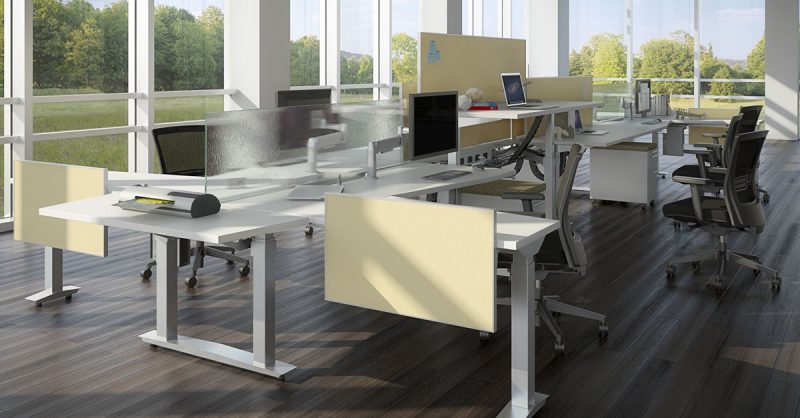Standing seems pretty easy, right? But just like sitting, it can actually lead to painful health issues if you’re doing it too much – or doing it wrong.
The human body is designed to move, so while sitting is “killing you,” standing for long periods of time isn’t helping you either. Enter: the sit-to-stand desk – giving workers the best of both worlds. So if you’re ready to invest in your health with a sit-to-stand solution, here are 7 tips to ensure you’re maximizing all the benefits.
 Alternate Positions Frequently
Alternate Positions Frequently
Just the act of going from sitting to standing alone burns calories. It also gets your blood flowing and alleviates the strain and fatigue from being in any one position for too long. The more you do switch it up the better. Research suggests a 1:1 or 2:1 ratio of sitting vs. standing for optimal comfort and energy. But any busy day can make it easy to forget, so try setting a timer as a reminder. Likewise, unlike sitting, even when you’re standing you have more freedom to adjust your position as often as you’d like. Even slight movements like swaying left and right, kicking back your legs, or going up on your toes can make a huge difference throughout the day.- Make Sure Your Desk or Screen Aren’t Too Low
Incorrect desk height and screen position are two of the biggest causes of discomfort and injury in the office. If you’re looking down at your screen while standing, then it’s too low. The same is usually true for anyone using a laptop at a standard height desk. Here are some tips: While standing, set your desk so your elbows are at a 90 degree position from the floor. For someone who is 5’11”, this would be about 44 inches high. The top of your screen should be at eye level with a slight upward tilt, and positioned about 20-28 inches from your face. - Make Sure Your Wrists are Flat
If you spend most of your day typing away on a computer, there’s nothing more frustrating than joint and muscle pain in your wrists. Make sure your wrists lay flat, about 180 degrees of your forearms. If your wrists are still bent at your desired desk height, try a keyboard pad to add the necessary support. - Try an Anti-Fatigue Mat
Most commercial grade carpets will hardly provide the necessary support to alleviate the strain of standing on a hard surface. Anti-fatigue mats are designed to combat leg exhaustion by encouraging slight movements of the muscles, which also reduces the pressure on your lower back. They typically average around $30, but can make a huge difference throughout the work day. It also doesn’t hurt to consider wearing shoes to work with a little more support, especially on days you’ll spend most of your time at your desk. - Stand After Eating
Always do a standing period right after you eat. You’ll be slightly more active than you would be while seated, which will help you burn some additional calories after a big lunch. - Watch Your Posture
If you follow our tips for proper working positions, then your posture should maintain itself. But it doesn’t hurt to check in with yourself throughout the day as poor posture is a hard habit to break. Set an alarm for a couple times an hour that reminds you to roll your shoulders back or extend your arms outward to stretch the muscles from your shoulders to your chest – they usually become the tightest for those who tend to slouch. - Pay a Little More for Memory Settings
While the benefits are totally worth it, trying to set that ideal height and posture multiple times a day can also be a bit of a pain. When you’re searching for a new sit-to-stand desk, consider those with control features that allow you to store up to 4 different memory settings, so your desk is always positioned just how you like it without any effort at all.
The mental and physical health benefits of a sit-to-stand desk (< insert link to previous blog!) are endless, and with these helpful tips, you can be sure you’re reaping all of them. For more information on sit-to-stand solutions, contact us today.
Source:
https://www.healthline.com/nutrition/6-tips-for-using-a-standing-desk#section5
